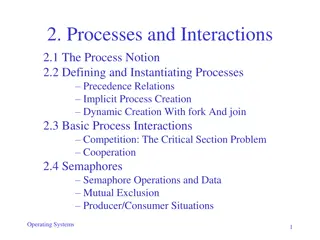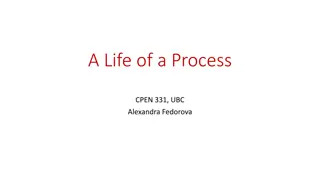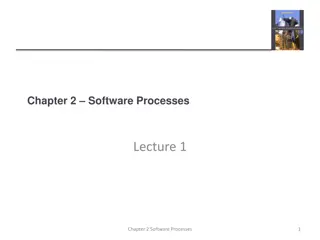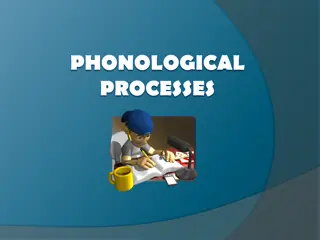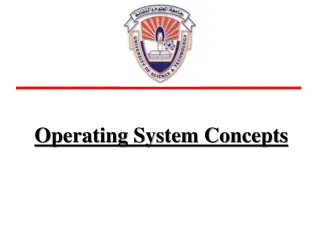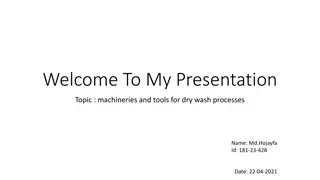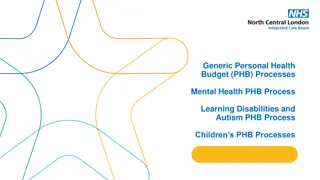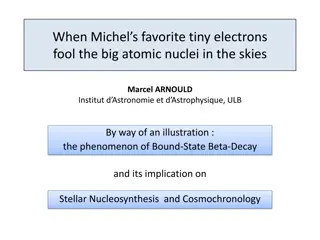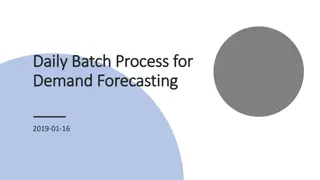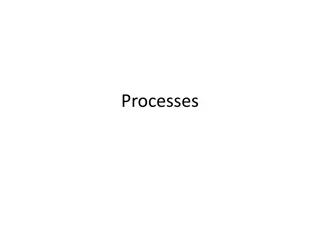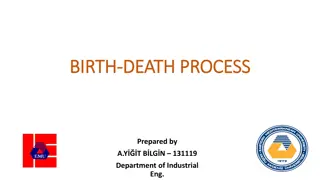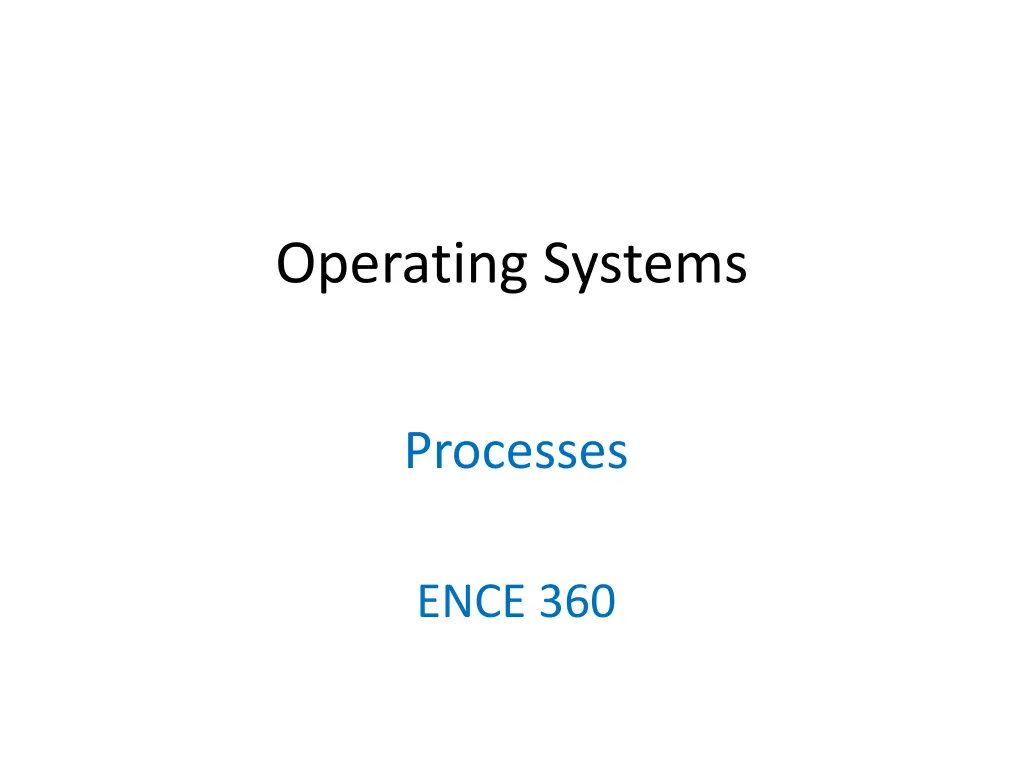
Understanding Operating Systems Processes and Solutions
Explore the world of operating systems processes, from the motivation behind control block switching to the solutions provided for managing multiple CPUs efficiently. Learn about process states, process scheduling, and the essential information needed to keep track of running programs.
Download Presentation

Please find below an Image/Link to download the presentation.
The content on the website is provided AS IS for your information and personal use only. It may not be sold, licensed, or shared on other websites without obtaining consent from the author. If you encounter any issues during the download, it is possible that the publisher has removed the file from their server.
You are allowed to download the files provided on this website for personal or commercial use, subject to the condition that they are used lawfully. All files are the property of their respective owners.
The content on the website is provided AS IS for your information and personal use only. It may not be sold, licensed, or shared on other websites without obtaining consent from the author.
E N D
Presentation Transcript
Operating Systems Processes ENCE 360
Outline Motivation Control block Switching Control Chapter 4 Chapter 2 MODERN OPERATING SYSTEMS (MOS) By Andrew Tanenbaum OPERATING SYSTEMS: THREE EASY PIECES By Arpaci-Dusseau and Arpaci-Dusseau
The Problem Remember CPU program from day 1? Each ran as if was only program on computer B A C D THE CRUX OF THE PROBLEM: HOW TO PROVIDE ILLUSION OF MANY CPUS? Few physical CPUs available, so how can OS provide illusion of nearly-endless supply of said CPUs?
The Solution The Process A program in execution Running several at once provides pseudo-parallelism Time-sharing A A C B A B Program Counter B Conceptual View C C Time Low-level machinery (mechanisms) Answer question of how. E.g., how to keep program context High-level intelligence (policies) Answer question of which. E.g., which process to run Note: good design to separate!
Process States Consider the shell command: cat /etc/passwd | grep claypool 1. What is this command doing? 2. How many processes are involved?
Process States Consider the shell command: cat /etc/passwd | grep claypool Clean up Running Initialization Terminate Dispatch I/O request Create Interrupt 3 processes cat grep bash Ready Waiting I/O complete (See process states with top)
OS as a Process Scheduler cat ls ... disk vid OS Process Scheduler Simple OS view just schedule processes! Even OS services (e.g., file system) are just processes Small scheduler handles interrupts, stopping and starting processes (policy decides when) Ok, what are mechanisms needed to make this happen?
Program Process int g_x main() { ... } A() { f = open() ... } What information do we need to keep track of a process (i.e., a running program)? ?
Program Process int g_x main() { ... } A() { f = open() ... } int g_x main() { ... } A() { f = open() ... } Heap g_x I/O f Stack A main Low-level machinery (mechanisms) to store program context (Discuss policies later in scheduling) Current execution location Intermediate computations (heap and stack) Access to resources (e.g., I/O and files open) Process Control Block (PCB)
Outline Motivation Control block Switching Control (done) (next)
Process Control Block OS keeps one Process Control Block (PCB) for each process process state program counter registers memory management open devices OS keeps list/table of PCB s for all processes (use when scheduling) Code examples: SOS pcb.h : ProcessControlBlock Xv6 proc.h : proc Linux sched.h : task_struct
Process Control Block Summary Info List of typical attributes in PCB 12
Outline Motivation Control block Switching Control (done) (done) (next)
Process Creation When are processes created?
BIOS Process Creation Boot loader System initialization When OS boots, variety of system processes created init parent of all processes (pid 1) Background, don t need to interact with user (daemonsfor guiding spirit ) Note, foreground processes get input from user Created on demand by user Shell command or, e.g., double clicking icon Execution of system call Process itself may create other processes to complete task Created by batch job Queued awaiting necessary resources. When available, create process(es) init Daemons Shell User command User command
Process Termination When are processes terminated?
Process Termination Voluntarily Make system call to exit() or return from main() Involuntarily By OS if misbehave e.g., divide by zero, invalid memory access By another process (e.g., kill or signal())
Creation/Termination Example Unix Shell System call: fork() Creates (nearly) identical copy of process Return value different for child/parent System call: exec() Over-write with new process address space Shell Uses fork() and exec() Simple! See: shell-v0.c See: shell-v1.c
Model for Multiprogramming CPU switches from process to process Each runs for 10s or 100s of milliseconds Block for I/O E.g., disk read Other interrupt E.g., I/O complete timeslice is over (configurable parameter) scheduled Silberschatz & Galvin, 5th Ed, Wiley, Fig 4.3 Operating System Concepts 19
Context Switch Pure overhead So want it to be fast, fast, fast typically 1 to 1000 microseconds Sometimes special hardware to speed up Real-time wants worst case (e.g., max 20 microseconds) When to switch contexts to another process is process scheduling
Interrupt Handling Mechanism Store PC (hardware) Load new PC (hardware) Jump to interrupt service procedure Save PCB information (assembly) Set up new stack (assembly) Set waiting proc to ready (C) Service interrupt (C and assembly) Invoke scheduler (C) Newly awakened process (context- switch) Previously running process
Outline Motivation Control block Switching Control (done) (done) (done) (next) Chapter 6 OPERATING SYSTEMS: THREE EASY PIECES http://pages.cs.wisc.edu/~remzi/OSTEP/cpu-mechanisms.pdf
The Problem Virtualizing CPU with Control A A Illegal! (e.g., read()w/out perm) B Ready?! Time Time THE CRUX OF THE PROBLEM: HOW TO EFFICIENTLY VIRTUALIZE CPU WITH CONTROL? OS must virtualize CPU efficiently while retaining control over system. Note: hardware support required!
Solution Limited Direct Execution Still allow programs to directly run (e.g., on CPU) i.e., no sandbox interpretation But limit permissions Hardware provides two (sometimes more) modes User mode certain operations/access not allowed Kernel mode full access allowed Allows OS to protect against Faulty processes Malicious processes Some instructions and memory locations are designated as privileged Only executable or accessible in kernel mode System calls, traps, and interrupts change mode from user to kernel Return from system call resets mode to user
Trap Transition User to Kernel Mode Save {pc, registers, return} to stack Restore (pop) stack But wow to know what code to execute for system call? i.e., how to know where system call is?
Trap System Call Lookup Table syscall number syscall table Each system call has own number/identity Initialized at boot time Kernel trap handler uses syscall number to index into table of syscall routines Unique to each OS
Inside Kernel Mode, OS can Not readable or writeable in user mode Read and modify data structures not in user address space Control devices and hardware settings forbidden to user processes Invoke operating system functions not available to user processes Access address of space of invoking process SP PC
Involuntary Transition User to Kernel Mode E.g., in user mode, memory violation generates interrupt Limit Register Memory yes CPU < no error Switch to kernel mode Handle error (e.g., terminate process)
The Problem Virtualizing the CPU A A ? Illegal! (e.g., read()w/out perm) B Ready?! Time Time THE CRUX OF THE PROBLEM: HOW TO EFFICIENTLY VIRTUALIZE CPU WITH CONTROL? What if process doesn t voluntarily give up control? It doesn t make a system call (so, can t check) and it doesn t make a violation. e.g., while(1) {}
Solution Special Timer Hardware Pulse from 5 to 300 MHz Decrement counter when == 0 generate interrupt Crystal Oscillator Holding register to load counter Use to control clock ticks (i.e., length of timer) When timer interrupt occurs, OS regains control E.g., can run scheduler to pick new process
Outline Motivation Control block Switching Control (done) (done) (done) (done)

